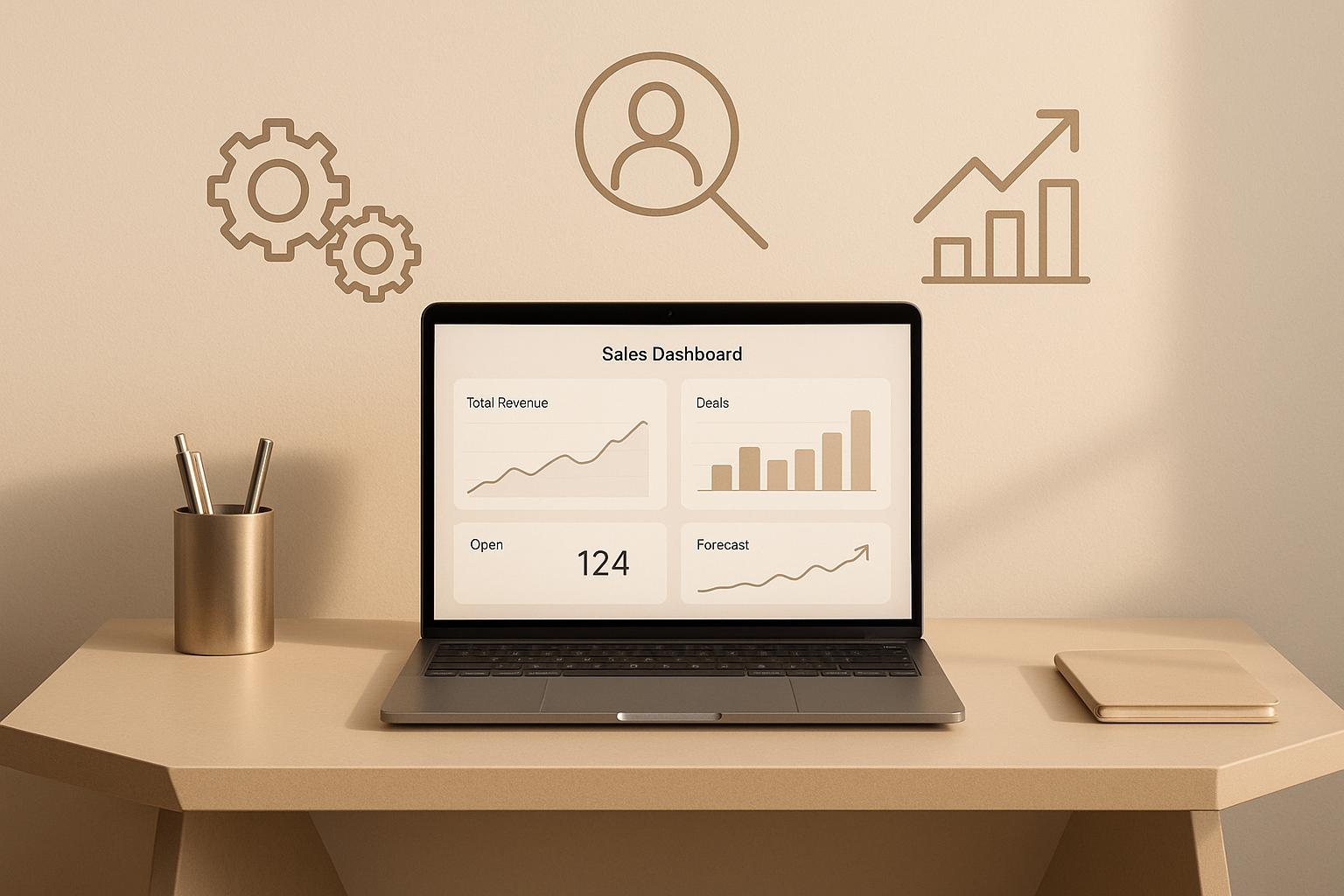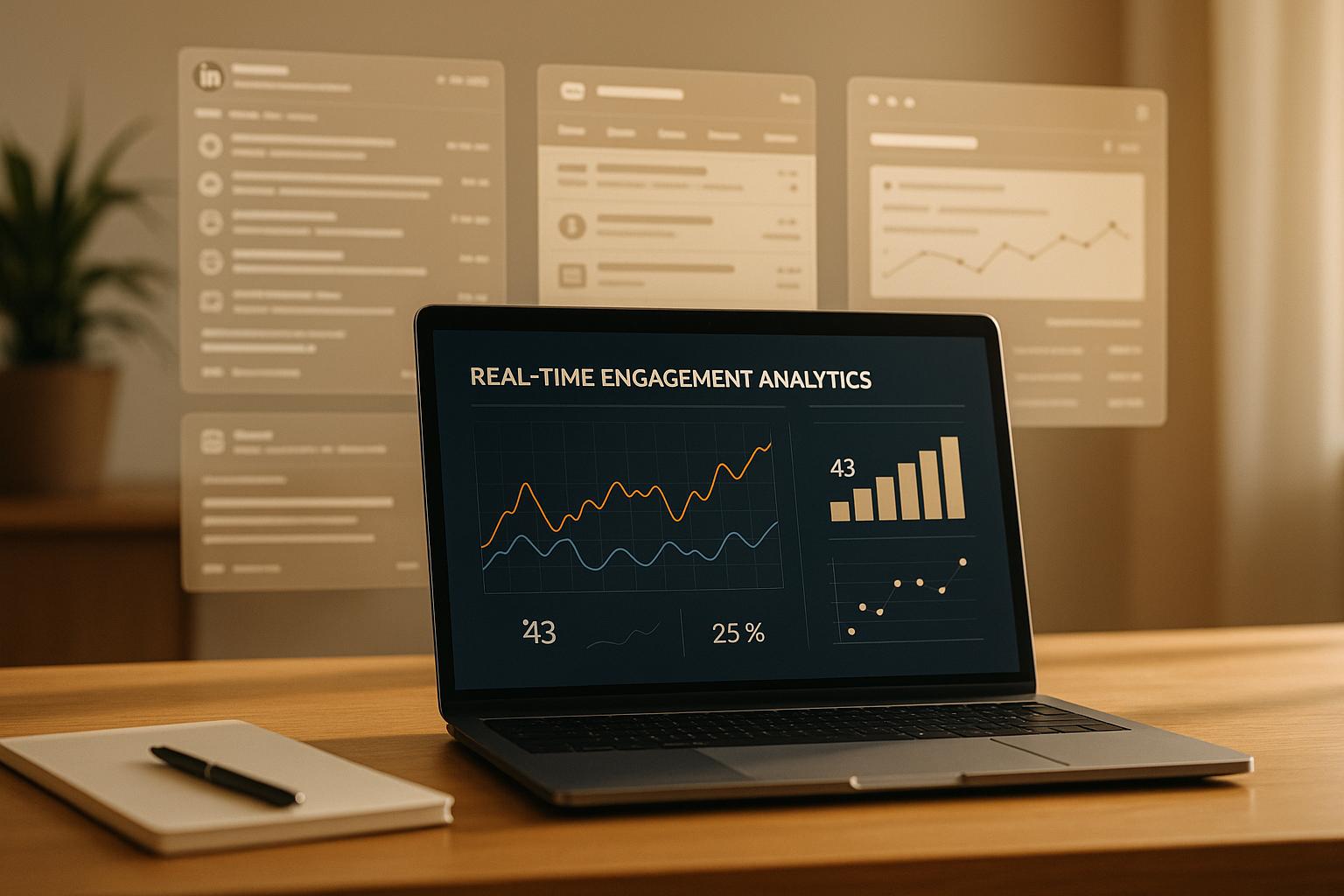
.avif)
Julien Gadea
Julien Gadea specializes in AI prospecting solutions for business growth. Empowering businesses to connect with their audience with SalesMind AI tools that automate your sales funnel, starting from lead generation.
AI is transforming sales by automating repetitive tasks like lead qualification, follow-ups, and data entry, saving teams up to 50% of their time. These tools go beyond automation, offering features like real-time coaching, tone analysis, and predictive analytics for sharper decision-making. Sales teams can focus more on building relationships and closing deals, while AI handles the heavy lifting.
Key Takeaways:
- Automates routine tasks (e.g., scheduling, data entry).
- Improves lead scoring with real-time updates.
- Enhances forecasting accuracy through data analysis.
- Centralizes communication with unified inboxes and CRM integration.
AI tools like SalesMind AI streamline workflows and help sales teams prioritize high-value tasks, leading to better efficiency and revenue growth.
How to Use AI in Outbound Sales: Automate Tasks, Not Human Connection
Key Benefits of AI Sales Task Automation
AI-powered automation is reshaping sales teams by making processes faster, smarter, and more effective. From streamlining everyday tasks to sharpening lead qualification and improving forecasting, these tools are driving productivity and better results across the board.
How AI Improves Efficiency
Imagine offloading tedious tasks like data entry, scheduling, and follow-ups - AI makes that possible. It can handle routine chores like sending follow-up emails, booking appointments, and updating contact records. This frees up sales reps to focus on what they do best: building relationships and closing deals.
AI also optimizes resource management by automatically assigning tasks based on team members' availability and expertise. This ensures that high-priority leads get the attention they deserve without delays. The result? A smoother workflow and more time spent on strategic initiatives.
Smarter Lead Management and Qualification
Traditional lead qualification can feel like guesswork, relying on limited data points. AI changes the game by analyzing vast datasets to pinpoint the most promising prospects. It considers factors like company size, industry trends, and engagement history to generate lead scores. These scores help sales teams zero in on opportunities with the highest potential.
This smarter prioritization leads to better conversion rates and ensures that resources are allocated effectively. Plus, AI keeps lead qualification dynamic, updating scores in real time as prospects engage with marketing materials or sales outreach. This means your team can respond faster and more accurately to potential buyers.
On top of that, AI doesn’t just stop at managing leads - it also plays a crucial role in refining sales strategies through accurate forecasting.
Sharper Sales Forecasting and Reporting
AI brings clarity to pipeline management with predictive analytics. By analyzing past data, current deal statuses, and market trends, it delivers highly accurate sales forecasts. These insights empower teams to make smarter decisions about where to focus their efforts and resources.
Automated reporting tools monitor deals in progress, flagging bottlenecks and highlighting opportunities that need immediate attention. They also provide a clear view of sales trends over time, helping teams refine their strategies and focus on activities that drive results. With AI’s help, sales teams can stay ahead of the curve and make data-backed decisions with confidence.
Core Features of AI-Powered Sales Tools
When evaluating AI-powered sales tools, it's important to look for features that go beyond basic automation. The best platforms combine intelligent lead handling, tailored outreach, and centralized systems to tackle everyday sales challenges. These elements make it easier to integrate AI into sales workflows effectively.
Automated Lead Qualification and Scoring
AI takes the guesswork out of sorting prospects by analyzing multiple data points at once. Factors like company size, industry trends, engagement history, and behavioral patterns are assessed to assign scores that reflect a lead's likelihood to convert. This results in prioritized lists that help sales teams focus on leads with genuine buying potential.
What sets modern lead scoring apart is its transparency. Jure, CEO of Jure Design, shared his experience:
"I like that it shows you a score on what the lead suitability with your filters is" [1].
Similarly, Svit Babarovic, CEO at MountainDrop, praised this feature:
"The lead scoring system is particularly impressive, providing clear insights into lead quality" [1].
These systems improve over time, learning from successful conversions to refine their scoring accuracy. The result? Sales teams can identify high-value prospects more effectively, boosting efficiency across the board.
Personalized Outreach and Follow-Ups
AI reshapes outreach by delivering messages that feel personal and well-timed. By analyzing LinkedIn profiles, company data, and past interactions, these tools craft messages that resonate with individual prospects. Timing is optimized to ensure messages land when prospects are most likely to engage.
SalesMind AI is a great example. It automates LinkedIn messaging, lead qualification, and follow-ups while maintaining a personal touch. For instance, if a prospect doesn’t reply to an email, the system might suggest sending a LinkedIn connection request. If someone engages with shared content, it could trigger an invitation for a product demo. Plus, multi-channel coordination ensures email, LinkedIn, and phone outreach efforts align seamlessly. This approach not only personalizes communication but also saves valuable time.
Unified Inbox and CRM Integration
A unified inbox consolidates all prospect communications - emails, LinkedIn messages, call notes, and meeting summaries - into one interface. This provides a complete history of interactions for every lead, making it easier to stay organized.
SalesMind AI’s unified inbox includes an AI co-pilot that offers ready-to-use responses, tags, and reminders. Rahul P., Senior Advisor at Bounty Media, highlighted how this feature has helped his team:
"SalesMind AI has proven very useful to our sales team in reducing the massive pain points of manually tracking each and every lead interaction. To have one master dashboard not just for yourself but for our entire team and try different lead lists, sequences, and track them all in real time is fantastic" [1].
When combined with CRM integration, this setup becomes even more powerful. All interactions are automatically synced with existing sales systems, ensuring data accuracy and creating detailed prospect profiles. This integration also enables advanced analytics, helping teams identify patterns in outreach success and pinpoint where prospects are falling off in the sales funnel. Together, these tools simplify communication and amplify efficiency.
sbb-itb-817c6a5
Step-by-Step Guide: Setting Up AI for Sales Task Management
Implementing AI to streamline your sales tasks doesn't have to be overwhelming. The process boils down to identifying inefficiencies, selecting the right tools, and ensuring your team knows how to use them effectively. Here's a clear roadmap to get started.
Identifying Workflow Challenges and Needs
Start by mapping out your sales process - from lead generation to closing deals. Take note of how long each task takes and identify where bottlenecks occur. These time-consuming activities are where AI can make the biggest impact.
Focus on repetitive tasks that eat up your team's time. For instance, manual data entry into your CRM, researching leads, scheduling follow-up emails, or updating prospect records are common culprits. If your sales reps are spending hours on these tasks daily, automation could be the solution.
Don’t forget to involve your team. Sales reps often have a clear sense of where time is being wasted but may not have had the chance to share their insights. Their input can be invaluable.
Dive into your sales metrics, such as response times and conversion rates, to uncover inefficiencies. For example, if it’s taking more than an hour to respond to inbound leads or too much time is spent researching prospects, these are areas where AI can step in to improve efficiency.
Once the problem areas are clear, you’ll be ready to choose an AI tool that directly addresses these challenges.
Selecting and Setting Up the Right AI Tool
With a clear understanding of your workflow issues, the next step is choosing an AI tool that integrates seamlessly with your existing systems. Avoid tools that create isolated data silos - compatibility with your CRM and other platforms is essential.
Take SalesMind AI, for example. It offers LinkedIn outreach automation, B2B lead generation, and an AI-powered inbox, all while integrating smoothly with platforms like LinkedIn. For teams that prioritize outbound prospecting and relationship-building through LinkedIn, this tool can be a game-changer.
Set specific goals for your automation efforts. For instance, aim to reduce manual follow-ups by 50% or cut lead response time to under 30 minutes. These measurable targets will guide your setup and help you evaluate the tool's success.
During setup, connect the AI tool to your CRM and communication platforms. For SalesMind AI, this could mean syncing LinkedIn accounts and importing your existing customer database. Establish automation rules tailored to your sales process, such as lead scoring criteria or follow-up sequences that align with your typical sales cycle.
Before rolling it out to your entire team, run a pilot program. Select a few experienced sales reps to test the tool and provide feedback. This step allows you to fine-tune the system and address any issues before full implementation.
Training Your Team and Monitoring Results
Once your AI tool is up and running, the next step is ensuring your team knows how to use it effectively and tracking its impact on performance.
Provide thorough training on how to use the tool and interpret AI recommendations. While AI can handle many tasks, sales reps will still need to know when to rely on their judgment.
Host workshops where team members can practice with real-world scenarios from your sales process. Supplement these sessions with video tutorials and written guides for ongoing reference.
Ongoing support is critical for adoption. Schedule regular check-ins to address any challenges and provide clear communication about the benefits of the tool. Change can be tough, so patience and support during the learning phase go a long way in building confidence.
Users of SalesMind AI have emphasized the importance of responsive customer support. As one user shared, having access to knowledgeable and invested support staff made a big difference in their team's success [1].
Finally, track key performance indicators to measure the tool’s impact. Metrics like time saved on manual tasks, the number of qualified leads generated, lead-to-customer conversion rates, and response times will give you a clear picture of how the AI is performing.
Use features like AI-powered lead scoring to assess lead quality. These systems highlight which prospects are most likely to convert, helping your team focus their efforts on high-potential opportunities. Regular performance reviews can reveal what’s working and where adjustments might be needed.
A centralized dashboard can be a powerful tool for your team. It allows everyone to monitor lead lists, follow-up sequences, and individual interactions in real time. Managers can use this visibility to replicate successful strategies across the team and quickly address any gaps in performance.
Tracking Success and Improving AI Sales Strategies
Once your AI tools are set up, the next step is to measure their impact and refine your approach to ensure a strong return on investment (ROI). This phase is crucial for maintaining the efficiency gains you aimed for earlier.
Measuring Key Performance Indicators (KPIs)
To evaluate success, focus on metrics that align with your AI goals.
Time savings is often the most noticeable benefit. For instance, AI-powered CRM automation can cut down manual tasks significantly - reducing daily data entry from 2 hours to just 30 minutes[2].
Lead quality and conversion rates are critical indicators of whether AI is improving your sales outcomes. It's not just about working faster; it's about working smarter. Track how many AI-qualified leads convert compared to manually qualified ones by monitoring your lead-to-customer conversion rate monthly.
Response times are another essential metric, especially in B2B sales. AI can drastically reduce the time it takes to respond to new leads. For example, instead of taking hours, your team could reply to inbound leads within 30 minutes, which can make a big difference in engagement.
Revenue growth is the ultimate goal. Compare monthly and quarterly revenue figures before and after AI implementation. Look at overall revenue and revenue per sales rep for a complete picture of the impact.
SalesMind AI’s analytics tools can help you track engagement, response rates, and lead quality, making it easier to adjust your outreach strategies to align with U.S. business norms. Additionally, monitor team adoption rates - if only a few sales reps are using the AI consistently, you won’t see its full potential. Metrics like login frequency and feature usage can highlight who might need extra training.
These KPIs provide a foundation for refining workflows and maximizing results.
Improving and Customizing Sales Workflows
AI tools improve over time as they learn from your data, but regular adjustments are key to getting the most out of them.
Lead scoring models should be revisited every quarter. As your AI gathers more data, it may reveal patterns you hadn’t noticed before. For example, if leads from specific industries or company sizes show higher conversion rates, you can tweak your scoring criteria to prioritize those leads.
Use AI analytics to identify bottlenecks and make adjustments. If data shows that faster follow-up emails lead to better response rates, update your automation rules to prioritize those quick follow-ups.
Personalized outreach is now a must. AI tools can tailor messages based on a prospect's behavior and history[2]. Regularly review your automated templates and update them based on what’s working. If certain templates perform well, incorporate their elements into your broader strategy.
In the U.S. B2B market, prospects often prefer direct, results-focused communication over lengthy relationship-building emails. Adjust your AI-generated messages to be concise and highlight clear benefits early in the conversation.
Seasonal adjustments are another important consideration. Business activity often slows during the summer or around holidays like Thanksgiving and Christmas. Program your AI to adapt its outreach frequency and tone during these times.
Encourage your sales team to provide feedback on AI-generated insights. Their input can help fine-tune your models. For example, frontline reps can point out which AI recommendations work best and which need improvement.
By continuously refining your workflows, you can ensure that your AI tools deliver even better results over time.
Comparing Before and After AI Results
Documenting the impact of your AI tools is essential for justifying the investment and guiding future improvements. Present your findings in a way that highlights the benefits clearly.
A comparison table is a great way to showcase key metrics before and after AI implementation. Include specific timeframes and dollar amounts to make the improvements tangible. For instance:
| Metric | Before AI (Q1 2024) | After AI (Q3 2024) | Improvement |
|---|---|---|---|
| Lead Response Time | 4.2 hours | 45 minutes | 82% faster |
| Monthly Qualified Leads | 150 | 285 | 90% increase |
| Conversion Rate | 12% | 18% | 50% improvement |
| Revenue per Rep | $85,000 | $112,000 | 32% increase |
Visual aids, like bar charts, can make these results even clearer for stakeholders.
While numbers tell part of the story, don’t overlook qualitative benefits like improved team morale or reduced stress from repetitive tasks. Conduct quarterly surveys to gather this feedback.
Incorporate AI-specific metrics into your regular performance reviews to keep optimization top of mind. If you notice a drop in the quality of AI-qualified leads, investigate and make adjustments quickly.
Celebrate team success stories. For example, if a sales rep closes a major deal that originated from an AI-qualified lead, document the details. These real-world examples can be persuasive when presenting results to stakeholders or advocating for further AI investments.
Lastly, consider how AI integrates with your CRM and communication tools. By streamlining tasks and reducing duplicate efforts, AI can improve team coordination over time. These efficiency gains often build on themselves, leading to even greater results down the line.
Conclusion: Improving Sales Efficiency with AI
AI has reshaped how sales teams handle their daily tasks, turning time-consuming manual processes into streamlined, automated workflows. Teams that adopt AI-driven tools often see noticeable boosts in efficiency, better lead quality, and increased revenue.
But this shift goes well beyond basic automation. AI now acts as a virtual team member, taking on complex responsibilities like generating detailed reports, managing lead follow-ups, and offering real-time insights into sales performance[2]. These advancements not only enhance internal operations but also create opportunities for teams to gain a competitive edge in their markets.
For U.S. sales teams, AI tools simplify outreach and lead management, enabling meaningful, scalable interactions. SalesMind AI, for example, automates LinkedIn outreach, lead qualification, and follow-ups, helping sales teams engage prospects at scale while focusing on tasks that bring the most value. Its unified inbox and advanced lead scoring features ensure seamless communication and better prioritization, leading to quicker conversions and improved productivity.
What’s more, integrating these tools doesn’t require a complete system overhaul. AI platforms like SalesMind AI work with popular CRMs, making adoption straightforward and delivering fast results. This ease of implementation allows teams to start reaping the benefits almost immediately.
The impact of these tools is clear - greater operational efficiency and sustained growth. However, success with AI isn’t a one-and-done effort. It requires continuous measurement, refinement, and team-wide adoption. The most effective teams treat AI as a strategic partner, constantly tweaking their workflows based on data and feedback, ensuring that the technology evolves alongside their unique sales processes.
By adopting AI solutions like SalesMind AI, U.S. sales teams can scale personalized outreach, automate lead qualification, and handle follow-ups more effectively, driving measurable improvements in productivity and business outcomes[2]. The real question isn’t whether AI will reshape sales task management - it’s how quickly your team can harness its potential to stay ahead in today’s fast-moving market.
The future of sales is here, powered by intelligent automation that enhances human capabilities rather than replacing them.
FAQs
How does AI enhance lead scoring accuracy and what factors are considered?
AI takes lead scoring to the next level by processing massive amounts of data to detect patterns and predict which leads are most likely to turn into customers. It considers a variety of factors, including a prospect's engagement history, demographic details, company size, and online activity.
By automating this process, AI removes the uncertainty, allowing sales teams to zero in on top-priority leads and make decisions based on solid data. Tools like SalesMind AI make this even smoother with advanced lead scoring capabilities, helping teams save time and work more efficiently.
How can sales teams effectively integrate AI tools with their current CRM systems?
To connect AI tools with your CRM system effectively, start by pinpointing the sales tasks or processes that could benefit from automation - think lead scoring, follow-ups, or outreach. Once you've identified these areas, make sure the AI tools you select work well with your CRM platform and allow for smooth data synchronization.
Don't overlook the importance of training your team. Ensure they understand both the AI platform and how it integrates with your CRM to fully harness its potential and boost adoption.
Keep an eye on how the integration performs over time, and tweak it as necessary to refine workflows and hit your sales targets. For instance, tools like SalesMind AI can simplify LinkedIn outreach, automate lead qualification, and handle follow-ups - all directly from your CRM - helping you scale your sales efforts more efficiently.
How can sales teams evaluate the impact of AI on their sales performance?
Sales teams can gauge how well AI is working by keeping an eye on key performance indicators (KPIs) that highlight changes in their workflows and results. Some of the most telling metrics include conversion rates, time spent on administrative tasks, lead response times, and revenue growth. By comparing these numbers from before and after introducing AI tools, teams can uncover valuable insights into the technology's impact.
Beyond the numbers, qualitative feedback also plays a role. For example, noticing improvements in customer satisfaction or a lighter workload for team members can signal positive changes. Tools like SalesMind AI, which feature automated lead qualification and personalized outreach, often come equipped with built-in analytics. These analytics can help sales teams evaluate how AI contributes to smoother processes and better outcomes.




